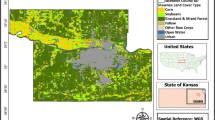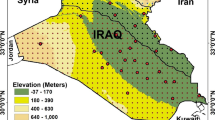Abstract
Satellite data provides important inputs far estimating regional surface emisslviiy and surface temperature. The methodology for estimation of emissivity over heterogeneous areas is based on the calculation of fraction vegetation cover per pixel taking NDVI, reflectances of pure pixels as input. The surface temperature is calculated using a sptit-window equation, which depends on atmospheric water vapour, viewing angle and channel surface emissivities. In the present study model coefficients for atmospheric corrections to NOAA AVHRR thermal data Fqr tropical atmospheres have been derived with a view to operationally use the methodolpgy for generating land surface temperature information from satellite data. The results of the study show that the estimated temperature values are comparable with the ctimatological values over the region Suggesting the possible use of the methodology.
Similar content being viewed by others
References
Becker F (1987). The impact of spectral emissivity on the measurement of land surface temperature from a satellite. Intn. J. Remote Sensing, 8:1509–1522.
Becker F and Li Z L (1990). Temperature — independent spectral indices in thermal Infrared bands, Remote Sensing Env., 32(17): 17–33.
Becker F and Li Z L (1993). Infrared remote sensing of surface temperature and surface spectral emissivities. NATO ASI series, High spectral resolution Infrared remote sensing for earth’s weather and climate studies. 19:265–284.
Caselles V and Sobrino J A (1989). Determination of Frosts in orange groves from NOAA-9 AVHRR data, Remote Sensing Env., 29:135–146.
Goita K and Royer A (1997). Surface temperature and emissivity separability over land surface from combined TIR & SWIR AVHRR data, IEEE Trans. Geoscience & Remote Sensing, 35(3):718–733.
Li Z L and Becker F (1993). Feasibility of land surface temperature and emissivity determination from AVHRR data. Remote sensing Env., 43:67–85.
Price J C (1990). Using spatial context in satellite data to infer regional scale evapotranspiration, IEEE Trans. Geoscience and Remote Sensing, 28(5):940–948.
Sobrino J A, Cesar C and Caselles V (1991). Atmospheric correction for land surface temperature using NOAA-11 AVHRR channels 4 and 5, Remote Sensing Env., 38:19–34.
Vidal A (1991). Atmospheric and emissivity correction of land surface temperature measured from satellite using ground measurements or satellite data. Intn. J. Remote Sensing, 12(12):2449–2460.
Valor E and Caselles V (1996). Mapping land surface emissivity from NDVI: Application to European, African & South American Areas. Remote Sensing Env., 57:167–184.
Author information
Authors and Affiliations
About this article
Cite this article
Kant, Y., Badarinath, K.(.S. atmospheric corrections to thermal IR data for estimation of land surface temperature. J Indian Soc Remote Sens 26, 113–120 (1998). https://doi.org/10.1007/BF03026668
Received:
Revised:
Issue Date:
DOI: https://doi.org/10.1007/BF03026668




